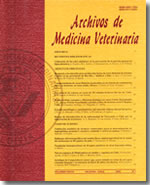Aspectos de manejo y bienestar en equinos de tiro urbano en el sur de Chile
Contenido principal del artículo
Resumen
En el sur de Chile los equinos de tiro continúan siendo la fuente principal de ingreso para numerosas familias. En muchas ocasiones estos equinos de trabajo no son mantenidos en óptimas condiciones. El objetivo de este estudio fue determinar las prácticas de manejo y parámetros relacionados con bienestar animal en un grupo de sesenta y un equinos carretoneros, pertenecientes a cincuenta propietarios, de tres ciudades del sur de Chile (Valdivia, Osorno y Puerto Montt). Se utilizaron métodos directos (basados en el animal) y métodos indirectos. Estos incluyeron aspectos de salud, comportamiento y prácticas de manejo. La mayoría de los equinos presentaron una conformación masisa, pero más pequeña que la de las razas de tiro clásicas encontradas en otras áreas templadas en el mundo. En general presentaron buena condición corporal (59%) y alertas (92%), con sólo unos pocos animales que presentaron una respuesta agresiva al momento de evaluar su comportamiento. Los principales problemas encontrados están relacionados con el manejo de cascos y las prácticas de alimentación. No se encontró asociación entre buena conformación de cascos y el uso de herreros o experiencia de los dueños. Esto se debe principalmente a una carencia de conocimiento y comprensión de prácticas de manejo y trabajo adecuados que permitan obtener un mejor rendimiento de sus equinos sin poner en riesgo el bienestar de éstos. La comunidad de dueños de equinos de trabajo se vería beneficiada con la instauración de programas educacionales en el futuro.

